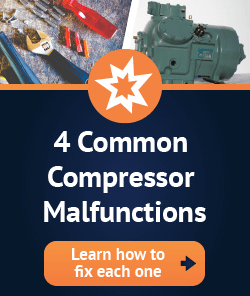Most of the time, problems in a commercial air conditioning system aren’t caused by the compressor. There are a number of simpler solutions that usually turn out to be the root cause. For example, an AC blowing lukewarm air typically needs more refrigerant – but the cooling cycle driven by the compressor is probably working fine.
Then there are those situations where the compressor really is at fault.
Replacing a commercial AC compressor is a major investment, but sometimes, there’s no alternative. When the compressor isn’t working, the rest of the system grinds to a halt. If a compressor is damaged, it could be highly inefficient. In that case, the cost of running it will soon outpace the cost of replacing it.
If there’s one silver lining in this situation, it’s this:
When you replace your commercial compressor, you almost never need to replace other components of the air conditioning system at the same time. As the “heart” of the system, a new compressor will bring the rest of the system back online and good as new unless a catastrophic failure has affected multiple components.
When Your Compressor Goes Down, Most Other Components Are Usually Safe
It’s never good news to have a compressor go down. In most cases, though, the other parts of your AC will be fine. Rather than trying to extend the life of a clearly damaged or struggling compressor, the best thing to do would be to replace it promptly. This limits the wear and tear that other AC components can experience.
Yes, there are some exceptions to this general rule.
For example, flooding and slugging not only affect the compressor but could also damage other components that are downstream of it. When you identify flooding, it’s crucial to bring the entire system to a halt as soon as possible so you can remediate the damage. Multiple components might need to be replaced.
Another exception comes when there’s a major electrical storm and your building sustains a direct hit from lightning. A building’s lightning protection system can divert these hits, but if it happens anyway, you could require widespread replacements as wiring damage contributes to the overload of multiple AC components.
If you suspect wiring damage or other electrical problems, it’s essential to remediate these issues before you replace your compressor. Otherwise, the new compressor will continue to be harmed as it receives incorrect voltages. That ages your equipment and could trap you in a cycle of ongoing replacement.
Outside of these and other environmental hazards that compromise a commercial AC’s operating environment, the compressor and the air conditioning parts it supports rarely need replacement at the same time. When you want to maximize your efficiency and reduce your cost of ownership, you simply replace the compressor.
For the Health of Your Air Conditioning System, Replace a Damaged Compressor Promptly
Although the compressor is vital to the rest of the air conditioning system, it is broadly self-contained. Stress on the system can be limited by replacing a compressor when you discover it is no longer operating as intended. A regular maintenance schedule will help you uncover any signs your compressor is ready to fail.
A damaged compressor limits what the rest of the system is able to do. When other components throughout an air conditioning system have problems, the compressor works harder to compensate. That keeps things going for a while, but the reverse isn’t true: No other part of the AC can compensate for poor compressor performance.
Luckily, replacing a damaged commercial compressor is easier than it once was.
Instead of waiting months to source a unit from an OEM-affiliated wholesaler, you can get a remanufactured commercial compressor. With a remanufactured commercial compressor, you save time and money. At the same time, you’ll reduce the cost of ownership for your AC by maintaining high performance longer.
Compressor Remanufacturing Is the Solution to Replace a Commercial AC Compressor Fast
With compressor remanufacturing, an existing compressor core is used as the basis of the new unit.
The compressor is thoroughly cleaned inside and out and maybe repainted. It is opened up and all internal parts are tested, with replacements being made as necessary. Before the unit is repackaged for return, it’s tested under load – “simulated real-world conditions” that verify it is ready to perform.
A remanufactured commercial compressor isn’t secondhand merchandise. It is not sent back to the customer until it is proven ready to deliver eight to ten years of excellent service. All fully remanufactured compressors should meet the unit’s performance and environmental commitments, and may even exceed them.
If your commercial AC compressor is on its last legs, focus your investment where it’ll make the most impact. You can save time, money, and frustration by choosing a remanufactured AC compressor for your system.












